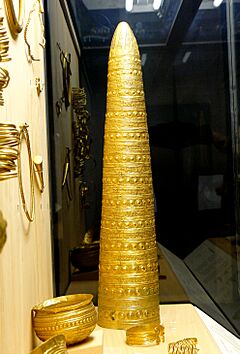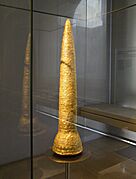Golden hat facts for kids
Golden hats are very special and rare objects from the Bronze Age in Europe. So far, only four of these amazing "cone-shaped gold hats" have been found. They are made from thin sheets of gold. These gold sheets were likely placed over tall, cone-shaped hats made of other materials, like leather or felt. This inner hat would have made the gold strong and stable.
The four known golden hats are:
- Avanton Gold Cone: Found in France in 1844. It's from around 1400 BC and is not complete.
- Golden Hat of Schifferstadt: Found in Germany in 1835. It dates to about 1400–1300 BC.
- Golden Cone of Ezelsdorf-Buch: Found in Germany in 1953. It's from about 1000–900 BC and is the tallest, at about 90 centimeters (35 inches).
- Berlin Gold Hat: Likely found in Germany or Switzerland. It dates to about 1000–800 BC and is now in a museum in Berlin.
We don't know exactly where all the hats were found. But at least two of them (Berlin and Schifferstadt) seem to have been carefully buried a long time ago. Even though we can't date them perfectly, their style suggests they were made between 1400 and 800 BC.
Contents
Amazing Gold Hats from the Bronze Age
What Are Golden Hats?
Golden hats are unique objects from the Bronze Age. This was a time when people used bronze to make tools and weapons. These hats are made of gold and are shaped like tall cones. They are very rare, with only four known examples found so far.
Where Were They Found?
The golden hats were found in different parts of Europe. Most were discovered in Germany and France. They show that people across a wide area shared similar ideas and skills during the Bronze Age.
How Were They Used?
Scientists believe these golden hats were important religious items. They might have been worn by priests or important leaders during special ceremonies. People at that time often worshipped the sun, and these hats might have been part of a sun cult. The hats were probably worn on the head, as they have an oval opening at the bottom, just like a human head.
Were They Also Calendars?
Some experts think the golden hats were more than just religious symbols. They might have also been used as complex calendars! The hats are covered in many patterns of circles and dots. These patterns might represent days, months, or even years.
The patterns could have helped people track the sun and moon cycles. This would have been very important for knowing when to plant crops or hold religious festivals, like the summer and winter solstices. We don't know for sure if they were used to tell time, or if they just showed off this special knowledge.
How Were Golden Hats Made?
Making these golden hats was incredibly difficult, especially for people living thousands of years ago.
The Gold They Used
The hats are made from a gold mix that is mostly gold (85-90%). It also has a little bit of silver, copper, and tin.
Hammering the Gold
Each hat was made from a single piece of gold. Workers hammered this gold until it was very thin, like paper. The thinnest part is about 0.25 millimeters (0.01 inches) thick. This made the hats surprisingly light. For example, the Ezelsdorf hat is 89 cm (35 inches) tall but weighs only 280 grams (about 10 ounces).
Hammering gold makes it harder and more likely to crack. To stop this, the ancient craftspeople had to heat the gold many times. They would heat it to about 750 degrees Celsius (1382 degrees Fahrenheit) to make it soft again. This was tricky because gold melts at a lower temperature (around 960 degrees Celsius or 1760 degrees Fahrenheit). They likely used charcoal fires and bellows to control the heat very carefully.
Adding the Decorations
After shaping the hats, artists added the beautiful patterns. They probably filled the hats with a soft material, like tree resin or wax. This would support the thin gold while they worked. Then, they used special tools to press or roll the patterns onto the gold. These patterns include disks, circles, and wheels.
Making these hats was a huge achievement for the people of the Bronze Age. It shows how skilled they were at working with metal and how much they knew about astronomy.
Gallery
-
Schifferstadt, Historical Museum of the Palatinate
Similar Ancient Gold Objects
The golden hats are part of a larger group of amazing gold objects from the Bronze Age. These include other gold crowns, bowls, and ornaments found across Europe. They all show how skilled people were at working with gold back then.
-
Mold gold cape, Wales, around 1900-1700 BC.
-
Nebra Sky Disc, Germany, around 1800 BC
-
Bush Barrow gold lozenge, England, around 1900 BC
-
Gold Casco de Leiro, Spain, 1400–1300 BC
-
Gold Commerford Crown, Ireland
-
Gold diadem from Mycenae, Greece.
-
Gold bowls from Midskov, Denmark, around 1000 BC.
-
Gold vessels, France, around 1400 BC
-
Gold disc, Czech Republic, 1650–1250 BC.
-
Gold appliqués from Lake Bled, Slovenia, 13th–12th century BC.
-
Gold collar from Austria, around 900 BC.
Where to See Them
The golden hats are usually kept in different museums. The Berlin Gold Hat is in the Museum für Vor- und Frühgeschichte in Berlin. The Schifferstadt hat is in the Historisches Museum der Pfalz in Speyer. The Ezelsdorf hat is in the Germanisches Nationalmuseum in Nuremberg. The Avanton hat is in the Musée d'Archéologie Nationale in Saint-Germain-en-Laye, France.
See also
- List of hats and headgear
- Casco de Leiro – a Bronze Age gold helmet from Spain
- Nebra sky disc – another ancient object showing knowledge of astronomy
- Pointed hat
- Trundholm sun chariot
- Tumulus culture
- Urnfield culture
























